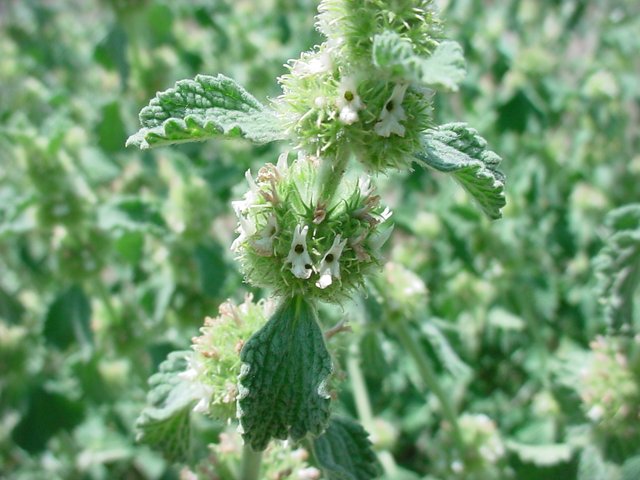Marrubium vulgare
Is a herb for fighting cough and phlegm

source: Western New Mexico University Department of Natural Sciences
Details:
Family: Lamiaceae
Latin name: Marrubium vulgare
English name: Horehound, hoarhound, White Horehound, Haryhound
Chinese name: -
Ayurveda name: -
Unani name: -
Greek name: Σκυλόχορτο
Parts used: Aerial parts, Roots
This herb has a long history of usage, in the past it has been attributed with magical powers and it was considered a great herb for protection against magic. It was used as a sacrament to god Horus.
One can find it in many Lozenges for cough in Europe but USDA has banned its usage in products in the US due to lack of evidence of efficacy. [1]##Geography:
Horehound can be found sprouting throughout Europe and is indigenous to Britain. It is really common in the counties of Norfolk and Suffolk. The locals sometimes grow it in the gardens for making tea or candy.
It is also found in Western and Central Asia, but it has also been introduced in North America and Australasia.[3]
Chemistry:
Marrubium vulgare contains many phytochemicals, the main being:
Marrubiin. It is formed during the extraction process from a precursor compound. [5]
- Caffeic acid derivatives [5]
- Flavonoids [5]
- Tetrahydroisoquinoline alkaloids [5]
-- Emetine [5]
-- Cephaeline [5] - Essential oil
Ethnobotany:
Western:
All-over Britain and especially in Ireland, Marrubium is widely used for cough, bronchitis and asthma. [3]
A suggested mechanism for its action on the treatment of the infections of the lower respiratory system looks something like this. The bitters in the extract cause the thinning of the phlegm that helps with its removal from the body. Within the thinner secretion new immune fighter cells are present that target the bacterial and viral invader. At the same time the herbs diaphoretic action allows perspiration to flow and tannins keep the tissues involved astringent.
The powdered leaves have also been employed as a vermifuge and the green leaves, bruised and boiled in lard, are made into an ointment which is good for wounds.
In Cambridgeshire(UK) expecting mothers used to drink an especially strong mixture of Marrubium with Rue (Ruta Graveolens) in order to delay birth. [3]
In Cumbria(UK) it is considered effective for nosebleeds. [3]
Horehound is sometimes combined with Hyssop, Rue, Liquorice root and Marshmallow root, 1/2 oz. of each boiled in 2 pints of water, to 1 1/2 pint, strained and given in 1/2 teacupful doses, every two to three hours.
Dosage:
Infusion: 1 or 2 teaspoons per cup, steep 10 to 12 minutes. Take 1 to 3 cups per day
Lozenge: As needed to soothe throat irritation.
Syrup: ½ to 1 teaspoon, 1 to 4 times per day
Tincture: 10 to 30 drops, 1 to 3 times per day
Chinese:
n/a
Ayurveda:
n/a
Other Cultures:
Many Native American tribes used the plant in formulations of the leaves, or the leaves and flowers extensively, for treating cough. They mixed it with honey for administration to children because the herb is extremely bitter , even more bitter than Gentian. They also used the root as an external topical poultice for Rheumatoid Arthritis. [7]
Clinical:
According to European Pharmacopoeia it fulfills the 30 year of minimum usage as a medicinal herb, so it can be considered a traditional medicinal herbal product. [6]
German Commision E has approved Marrubium vulgare for dyspeptic complains and for loss of appetite. [5]
It also has a record for usage as a Choleretic or Cholagogue herb. [5]
Lately, there is great interest in research M. vulgare as a herb used diabetes, due to claimed hypoglycemic action. In fact quite a few studies show that there might be some basis to this claim. [8]
Other Uses:
Veterinary:
In veterinary medicine Marrubium vulgare has been used for treatment of respiratory disorders and for urinary infections [4]
Pest management:
According to Columella, Horehound is a serviceable remedy against Cankerworm in trees, and it is stated that if it be put into new milk and set in a place pestered with flies, it will speedily kill them all. [1] Cankerworm is probably a caterpillar that is a stage of locust lifecycle.
Marrubium has a bitter taste that is not favorable by grasshoppers, that's why it is used as a companion plant for tomatoes. Usually, it is planted as a border fence. (citation needed)
Culinary:In the UK in Norfolk and other country districts is also brewed and made into Horehound Ale, an appetizing and healthful beverage, that is quite popular. [2]
It was also used for making candy in the Uk as well by the Native Americans.
Safety Toxicity:
Extended use may lead to hypertension. While large doses can cause vomiting. [1]
References:
- Pursell, J. J. The herbal apothecary : 100 medicinal herbs and how to use them. Portland, Oregon: Timber Press, 2016. Print. pgs 112-113
- Hoffmann D. Medical Herbalism. Healing Arts Press; 2003.
- Allen, David E., and Gabrielle Hatfield. Medicinal plants in folk tradition : an ethnobotany of Britain & Ireland. Portland OR: Timber Press, 2004. Print.
- Katerere, David R., and Dibungi Luseba. Ethnoveterinary botanical medicine : herbal medicines for animal health. Boca Raton: Taylor & Francis, 2010. Print.
- Capasso, Francesco, et al. Phytotherapy : a Quick Reference to Herbal Medicine. Berlin, Heidelberg: Springer Berlin Heidelberg, 2003. Print.
- European Pharmacopeia Monography Merrubium vulgare(pdf)
- Moerman, Daniel E. Native American ethnobotany. Portland, Or.: Timber Press, 2010. Print.
- Ahmet A. Elberry. et.al . Methanolic extract of Marrubium vulgare ameliorates hyperglycemia and dyslipidemia in streptozotocin-induced diabetic rats. International Journal of Diabetes Mellitus. Vol3 May 2015 (Open Access article)
- USDA page for Marrubium vulgare
- Find it in California